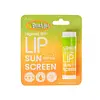What's inside
What's inside
 Key Ingredients
Key Ingredients

 Benefits
Benefits

 Concerns
Concerns

 Ingredients Side-by-side
Ingredients Side-by-side

Octyldodecanol
EmollientRicinus Communis Seed Oil
MaskingCera Alba
EmollientHydrogenated Rapeseed Oil
EmollientButyl Methoxydibenzoylmethane
UV AbsorberEthylhexyl Salicylate
UV AbsorberButyrospermum Parkii Butter
Skin ConditioningCetyl Palmitate
EmollientBis-Ethylhexyloxyphenol Methoxyphenyl Triazine
Skin ConditioningEthylhexyl Triazone
UV AbsorberAroma
Helianthus Annuus Seed Oil
EmollientTocopherol
AntioxidantLinalool
PerfumingCitronellol
PerfumingOctyldodecanol, Ricinus Communis Seed Oil, Cera Alba, Hydrogenated Rapeseed Oil, Butyl Methoxydibenzoylmethane, Ethylhexyl Salicylate, Butyrospermum Parkii Butter, Cetyl Palmitate, Bis-Ethylhexyloxyphenol Methoxyphenyl Triazine, Ethylhexyl Triazone, Aroma, Helianthus Annuus Seed Oil, Tocopherol, Linalool, Citronellol
Ricinus Communis Seed Oil
MaskingCaprylic/Capric Triglyceride
MaskingCera Microcristallina
Emulsion StabilisingEthylhexyl Methoxycinnamate
UV AbsorberC15-19 Alkane
SolventEthylhexyl Salicylate
UV AbsorberButyl Methoxydibenzoylmethane
UV AbsorberWater
Skin ConditioningHydrolyzed Jojoba Esters
Skin ConditioningCera Alba
EmollientEthylhexyl Triazone
UV AbsorberDiisobutyl Adipate
EmollientTocopheryl Acetate
AntioxidantPolysorbate 80
EmulsifyingAnthemis Nobilis Flower Extract
MaskingSaccharide Isomerate
HumectantCandelilla Cera
EmollientCaprylyl Glycol
EmollientCetyl Alcohol
EmollientSilica
AbrasiveSodium Saccharin
MaskingBisabolol
MaskingRicinus Communis Seed Oil, Caprylic/Capric Triglyceride, Cera Microcristallina, Ethylhexyl Methoxycinnamate, C15-19 Alkane, Ethylhexyl Salicylate, Butyl Methoxydibenzoylmethane, Water, Hydrolyzed Jojoba Esters, Cera Alba, Ethylhexyl Triazone, Diisobutyl Adipate, Tocopheryl Acetate, Polysorbate 80, Anthemis Nobilis Flower Extract, Saccharide Isomerate, Candelilla Cera, Caprylyl Glycol, Cetyl Alcohol, Silica, Sodium Saccharin, Bisabolol
Ingredients Explained
These ingredients are found in both products.
Ingredients higher up in an ingredient list are typically present in a larger amount.
Also known as Avobenzone, this ingredient is a chemical sunscreen filter that provides protection in the UV-A range.
Avobenzone is globally approved and is the most commonly used UV-A filter in the world.
Studies have found that avobenzone becomes ineffective when exposed to UV light (it is not photostable; meaning that it breaks down in sunlight). Because of this, formulations that include avobenzone will usually contain stabilizers such as octocrylene.
However, some modern formulations (looking at you, EU!) are able to stabilize avobenzone by coating the molecules.
Avobenzone does not protect against the UV-B range, so it's important to check that the sunscreen you're using contains other UV filters that do!
The highest concentration of avobenzone permitted is 3% in the US, and 5% in the EU.
Learn more about Butyl MethoxydibenzoylmethaneCera alba is beeswax, or the wax used by bees to make honeycombs. It is a texture-enhancer and emollient. A study from 2003 found beeswax to be a stronger emollient than ingredients such as petroleum jelly.
As an emollient, beeswax helps hydrate the skin by creating a barrier on top. This barrier traps moisture in.
Emulsifiers help prevent ingredients from separating. This helps create consistent texture.
The structure of beeswax is mainly long-chain alcohols and the esters of fatty acids.
There are three types of beeswax: yellow, white, and absolute. Yellow is pure beeswax taken from the honeycomb. White beeswax is created by filtering or bleaching yellow beeswax. Absolute beeswax is created by treating beeswax with alcohol. Beeswax used in cosmetics are purified.
Beeswax has been used throughout history and even in prehistoric times. Some common uses for beeswax still used today are making candles, as a waterproofing agent, and polish for leather.
Learn more about Cera AlbaEthylhexyl Salicylate is an organic compound used to block UV rays. It primarily absorbs UVB rays but offers a small amount of UVA protection as well.
Commonly found in sunscreens, Ethylhexyl Salicylate is created from salicylic acid and 2-ethylhexanol. You might know salicylic acid as the effective acne fighter ingredient and BHA.
The ethylhexanol in this ingredient is a fatty alcohol and helps hydrate your skin, similar to oils. It is an emollient, which means it traps moisture into the skin.
According to manufacturers, Ethylhexyl Salicylate absorbs UV wavelength of 295-315 nm, with a peak absorption at 307-310 nm. UVA rays are linked to long term skin damage, such as hyperpigmentation. UVB rays emit more energy and are capable of damaging our DNA. UVB rays cause sunburn.
Learn more about Ethylhexyl SalicylateEthylhexyl Triazone is a modern chemical sunscreen that protects from UV-B radiation.
It is the most effective of existing UV-B filters, as it provides the highest level of photo-stable absorption. It protects from the entire UV-B range (280 to 320nm), with it's highest level of protection at 314nm.
Ethylhexyl Triazone is oil soluble, oderless and colorless, which mean it is able to be incorporated into a variety of different formulations.
It is not currently available within the United States due to slow changing FDA regulations. Outside of the US, it is used in formulations at concentrations up to 5%.
Learn more about Ethylhexyl TriazoneRicinus Communis Seed Oil is the INCI name for castor oil.
Castor Oil helps moisturize the skin. It is rich in a fatty acid called ricinoleic acid. This fatty acid helps prevent moisture loss on the skin. This helps keep your skin soft and hydrated. Ricinoleic acid also has anti-inflammatory and pain reducing properties.
Besides hydrating the skin, castor oil is also used to hydrate hair. By keeping the hair shaft moisturized, breakage is decreased. More studies are needed to show castor oil's effective on stimulating hair growth.
Castor oil is created by cold-pressing castor seeds and then purifying the oil with heat. It was used in Ancient Egypt as fuel in lamps and to help treat eye irritation.
The term 'fragrance' is not regulated in many countries. In many cases, it is up to the brand to define this term. For instance, many brands choose to label themselves as "fragrance-free" because they are not using synthetic fragrances. However, their products may still contain ingredients such as essential oils that are considered a fragrance.
Learn more about Ricinus Communis Seed Oil